Condensed matter and surface physics represents the single largest area of world-wide physics research. These subjects encompass a diverse range of theoretical and experimental sub-fields such as correlated systems, magnetism, nanomaterials, and systems with surfaces and interfaces. The condensed matter and surface science group has seven faculty members (Daniel Agterberg, Marija Gajdardziska-Josivovska, Prasenjit Guptasarma, Carol Hirschmugl, Lian Li, Paul Lyman, and Michael Weinert) and one Adjunct Professor Emeritus (Bimal Sarma) participating in numerous projects involving experimental and/or theoretical aspects. This group interacts with students, colleagues in other departments, members of the interdisciplinary Laboratory for Surface Studies, and researchers at various national user facilities.
Laboratory for Surface Science
The Laboratory for Surface Studies (LSS) is an interdisciplinary research center at UWM comprised of faculty and students from chemistry, physics, and engineering, united by the desire to understand the structural, chemical, electronic, and magnetic properties of materials at the nanoscale. Started in the mid-1960s and designated a University of Wisconsin Center of Excellence, LSS remains a leading and vibrant part of the UWM research environment. The experimental and theoretical research activities today span a broad range of topics, from traditional problems in surface science, to current areas of interest such as biophysics, nanotechnology, tribiology, catalysis, and materials science at the atomic scale.
Faculty Research
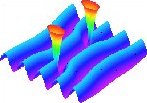 Two half-Vortices coupled to dislocations in a PDW superconductor
Two half-Vortices coupled to dislocations in a PDW superconductor
Daniel Agterberg is a theorist working in the area of superconductivity and strongly correlated electronic materials, focusing on topics such as the nature of high-temperature superconductors and the consequences of topological structures on electronic wave functions. His research is driven by close communications with experimentalists to identify relevant problems that lie at the forefront of materials science, and combines analytical many-body/symmetry-based techniques with numerical calculations. He has recently collaborated with Scientists at Cornell University, the Swiss Federal Institute of Technology (ETH-Zurich), Stanford University, and the University of Tokyo.
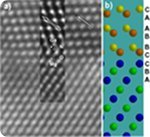 HRTEM of Fe3O4(111)/MgO(111) polar surface
HRTEM of Fe3O4(111)/MgO(111) polar surface
Marija Gajdardziska-Josifovska’s group uses atomic resolution transmission electron microscopy, diffraction, and spectroscopy methods to understand how the combination of ionicity and limited dimensionality leads to new physical properties and useful applications. Her funded research program aims to elucidate the stabilization mechanisms for polar oxide surfaces and interfaces by studying their atomic and electronic structures. The focus is on polar oxide systems with applications in energy, environment, and novel forms of electronics. Her group also works with a wide range of nanostructures, with recent funded work on hybrid nanosensors, based on tin oxide nanoparticles supported on carbon nanotubes or graphene sheets, and complex oxide nanoparticles with promising multiferroic properties. In the area of biophysics she collaborates with colleagues from the life sciences to develop targeted magnetic nanotechnology therapies for stroke and cancer, and to study naturally occurring magnetic nanocrystalline biominerals created by the iron storage proteins in plants and bacteria. She has contributed to technique developments in nanodiffraction, electron holography, reflection electron microscopy, and dynamical in-situ transmission electron microscopy. Her research has been supported by grants from the National Science Foundation, the Department of Energy, and the Research Corporation.
For more information: Gajdardziska-Josifovska’s Research Website
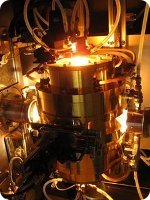 Floating zone crystal growth chamber
Floating zone crystal growth chamber
Prasenjit Guptasarma is interested in the materials science of systems with strongly correlated electrons. His work seeks to elucidate the fundamental physics of unusual electronic and magnetic properties of materials, such as those near a critical phase transition, or bordering an unconventional quantum physical ground state. Current activities in his group include studies in the areas of novel superconductivity and magnetism, ferroelectricity, and multiferroics. Guptasarma’s research lab hosts equipment for floating-zone growth of high-purity bulk single crystals, growth of nanostructures using high-pressure and solution-based techniques, and measurement of properties such as magnetic, transport, dielectric, specific heat, and ultrasound velocity, at extreme temperatures (350mK – 800K) and in magnetic fields (up to 9 Tesla). In addition, his group performs experiments at synchrotron light sources, neutron sources, and high magnetic field facilities in North America and abroad.
For more information: Guptasarma’s Research Website
Min Gyu Kim is interested in Quantum magnets – magnets in which quantum mechanical effects are strong and lead to unique and unexpected properties. With strong quantum effects, many interesting phenomena appear, such as spin density waves, fluctuation-driven superconductivity, topological states, and quantum spin liquids. His research goal is to study the role of quantum effects and provide a thorough understanding of the lattice, charge, and spin degrees of freedom and their complex interplay in exotic quantum magnets. Min Gyu Kim’s group use various elastic and inelastic x-ray and neutron scattering techniques that are ideal for studing the lattice, charge, and spin degrees of freedom of matter. They also seeks to discover new materials through various synthesizing techniques, for example, the solid-state reaction technique and the high-temperature solution growth technique. The ability to makie samples and use a variety of x-ray and neutron scattering techniques is the unique strength of their research group.
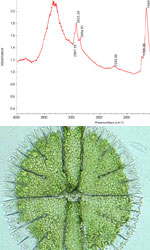 IR Spectra of Micrasterius Algae
IR Spectra of Micrasterius Algae
Carol Hirschmugl studies the surface physics of adsorbates on epitaxial and bulk oxide systems, focusing on environmentally and technologically relevant problems. Her investigative approaches include far and mid-infrared absorption spectroscopy and picoampere low energy electron diffraction to study low energy dynamics and structure at aqueous-oxide interfaces. In addition, Hirschmugl is developing a rapid chemical imaging technique using infrared imaging microscope coupled to an synchrotron source, which will be used to examine real-time biochemical changes in vivo.
Prof. Hirschmugl is no longer supervising new students.
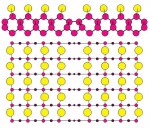 TeGe(001)-(1×1) bridge-site structure with missing Te row
TeGe(001)-(1×1) bridge-site structure with missing Te row
Paul Lyman conducts research focused on growth of novel thin films and determination of surface reconstructions. One principal effort (in collaboration with Prof. Dilano Saldin) involves developing and applying phase retrieval methods to help solve surface structures directly from x-ray diffraction data. Materials of interest include oxides and wide-bandgap semiconductors, especially the structure of polar oxides. In addition to standard UHV preparation methods, his group is interested in air-stable oxide reconstructions, and growth of thin epitaxial films using atomic layer deposition (ALD). The fine control afforded by the ALD technique allows the construction of novel multilayered materials, such as (Mg,Zn)O alloys.
Prof. Lyman is no longer supervising new students.
For more information: Lyman’s Research Website

Ionel Popa’s research focuses on developing and implementing new techniques to study the mechano-chemistry of proteins. At the nanoscopic level force is a ubiquitous perturbation and many proteins have evolved to respond to mechanical stimuli. These proteins are generally segregated in multiple domains and play key roles in processes such as cellular mechano-transduction and tissue elasticity. The lab develops biomimetic materials, which hold the promise of revolutionizing medicine by allowing for artificial organs and targeted drug release. The lab uses engineered proteins to obtain protein-hydrogels, which are a new type of material with unique properties. These amorphous materials can harvest from the biodiversity of proteins, while retaining large amounts of water (>90%), have a unique response to mechanical stress through the unfolding of the constituent protein domains and can respond to various stimuli. With these materials, his research aims to advance the fields of smart materials and soft biorobotics.
For more information: Popa’s Research Website
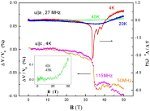 Ultrasonic properties or URu_2Si_2
Ultrasonic properties or URu_2Si_2
Bimal Sarma’s interest in condensed matter is the study of materials in extreme environments — at extremely low temperatures and extremely high magnetic fields. Sarma, whose work has spanned a wide arena of experimental physics from neutron diffraction to low-temperature techniques, has been concerned with the use of sound waves to investigate phase transitions and the actual phases themselves in magnetic systems and superconducting/superfluid systems. Sarma’s landmark study of heavy-fermion superconductors showed that the existence of a metallic superconductor whose microscopic behavior does not conform to the standard BCS model of electron-pairing and led to the remarkable discovery of multiple superconducting phases in UPt3. Sarma’s current studies involve high-Tc and heavy-fermion superconductivity and the phases of materials in some of the highest magnetic fields.
Prof. Sarma is no longer supervising new students.
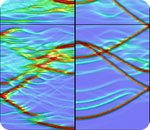 Calculated spectral weight for interfacial graphene on 6H-SiC(0001) and for epitaxial graphene
Calculated spectral weight for interfacial graphene on 6H-SiC(0001) and for epitaxial graphene
Michael Weinert’s research is focused on understanding the electronic, magnetic, and structural properties of complex materials at the atomic level, primarily through the use of first-principles electronic structure calculations. Much of his research is done in close collaboration with experimentalists, both at UWM and elsewhere. Research topics include the effects of external electric fields on the electronic and magnetic properties of surfaces, interfaces, and nanostructures; phase stability of alloys and the role of defects; the electronic structure of oxides and related systems; magnetic semiconductors; the interpretation of various electron spectroscopies (e.g., STM, APECS, photoemission); and the development of new computational approaches and high-performance (parallel) computing applied to materials physics.
For more information: Weinert’s Research Website